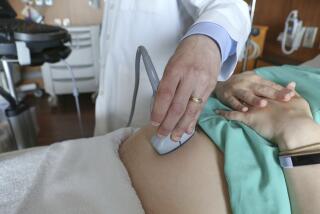Major Expansion of Health Clinics OKd
- Share via
Launching a new era of public health care in Los Angeles County, the Board of Supervisors on Tuesday unanimously approved the largest expansion of outpatient health clinics for the poor and uninsured in the county’s history.
But even as supervisors were increasing the number of clinics, 380 county health workers--including 51 at Olive View/UCLA Medical Center in Sylmar--received notices that they will be laid off or demoted in two weeks.
The addition of 36 new clinics is the first stage in a sweeping restructuring of the county’s health system from an emphasis on expensive hospital treatment to less costly preventive and primary care in the community.
The move also represents the county’s most extensive reliance on partnerships with private, mostly nonprofit medical groups, which will serve patients in their own facilities rather than county-owned clinics. In the past, there have been distinctly separate public and private health care systems in the county.
In the San Fernando and Antelope valleys, the Tarzana Treatment Center--which will operate three health centers--will become a major player in delivering health care.
By the end of the year, it is scheduled to open a facility at El Proyecto del Barrio social service center at 8902 Woodman Ave. in Arleta, expected to handle 5,625 patient visits each year.
An El Proyecto official said the building is being expanded to provide enough room for the clinic.
The Tarzana Treatment Center will also operate new clinics in Lancaster at 44447 N. 10th St. West and in Tarzana at 18646 Oxnard St. The Lancaster facility is expected to handle 13,500 patient visits a year, and 9,875 are expected at the Tarzana site.
The layoffs voted Tuesday will come primarily at Rancho Los Amigos, County-USC and Olive View.
Altogether, 90 permanent employees and 160 temporary employees will lose their jobs and 130 others will be demoted because of Civil Service protections based on seniority.
Although some of the displaced workers may end up finding jobs in the new private clinics, it will be the largest layoff of health workers since last fall, when the county’s worst-ever fiscal crisis cost more than 2,500 health workers their jobs.
At Olive View, Carolyn Rhee, the chief operating officer, said the hospital staff was unhappy about the layoffs, but that everyone had seen worse times.
“A lot of the staff is upset, although not to the extent that we were last year, and we are grateful for that,” she said. “I think we will be OK. We’ll have to be as efficient as possible and stretch our staff.”
In addition to the layoff of 13 permanent employees at Olive View, 38 temporary workers will lose their jobs, Rhee said. Also, there will be 34 demotions and transfers at the hospital.
The partnership contracts approved Tuesday with 20 health care organizations include provisions to give county health workers an edge in obtaining jobs in the private clinics.
The new clinics will be in downtown Los Angeles, South and South-Central Los Angeles, the South Bay, Long Beach and southeast-area cities, the Antelope Valley, San Fernando Valley and in the San Gabriel Valley as far east as Pomona. The operators range from small storefront clinics to large medical groups and include the Chinatown Service Center, the Watts Health Foundation, the Tarzana Treatment Center and Planned Parenthood Los Angeles.
“This is our first step in restructuring,” said Nancy Rubin, executive officer of the Department of Health Services.
The expansion in primary and preventive care is in keeping with the county’s promise to the federal government that it will eliminate at least one-third of its hospital beds and increase the number of outpatient visits at least 50% by the middle of 2000.
In return, the county received a $364-million federal bailout to rescue the health system from financial collapse last fall and $172 million this year to stabilize and transform the health system.
By paying for contractors to provide expanded outpatient services at the 36 new clinics, the county is seeking to rebuild the number of outpatient visits to more than 3.8 million this year, slightly less than had been provided before last fall’s budget cuts and layoffs.
Ultimately, the county must increase the number of outpatient visits to more than 6 million a year by the end of its five-year project to establish a more modern and efficient health care system.
Before the supervisors voted, representatives of health care organizations praised the new public-private partnerships.
Dr. Elisa Nicholas, medical and executive director of the Children’s Clinic in Long Beach, said her group will expand services to adults and treat more children.
Nicholas expressed some concern about the county maintaining enough specialists and adequate hospital care for poor and uninsured patients who will be seen in the private clinics. And she expressed concern about long-term funding.
“It is challenging enough to develop a new program, but once the community has accepted it and depends on it, I would hate to close it due to cessation of funding or contracts,” she said.
The county privatized six of its 39 health clinics in the midst of its health care crisis last fall, turning over the operation of the facilities to private operators without providing funds to pay for the services.
The Los Angeles area has the highest proportion of residents who are poor or lack health insurance of any major metropolitan area in the nation. There are 2.6 million county residents without health coverage, most of whom work, and an additional 1.6 million on Medi-Cal, the joint federal-state program for the poor.
More to Read
Sign up for Essential California
The most important California stories and recommendations in your inbox every morning.
You may occasionally receive promotional content from the Los Angeles Times.










